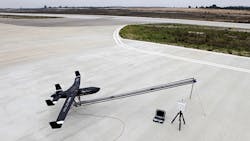Photonic sensors assess air quality for rapid-response drone
Reaching speeds of up to 120 km per hour and covering an 80 km radius, a drone fitted with a photonic sensor can simultaneously detect dozens of toxic gasses in an instant. Critical air quality information is needed for deploying emergency services, evacuations and survival in the aftermath of a catastrophic event, such as a volcanic eruption, a wildfire or a chemical plant explosion. Natural disasters like the infamous eruption of Iceland's Eyjafjallajökull in 2010 can severely impact air quality and safety in the short term and are often outside the reach of fixed monitoring station networks.
RELATED ARTICLE: Civilian drones get a research center as FAA faces political pressure
Flying through some of the toughest environments on earth such as dangerous clouds or poisonous plumes, the Flying ultrA-broadband single-shot Infra-Red Sensor or FLAIR drone aims to provide real-time air quality data used for quick decision-making during evacuations and the deployment of rapid response emergency services.
André Oliveira, project coordinator of Tekever Autonomous Systems, says, "For the first time, a drone reaching altitudes of up to 4000 metres will be able to detect fine traces of air molecules that are dangerous to our health with a state-of-the-art laser sensor. The drone can map out areas that are too dangerous for humans to go and can transmit data in real time to a ground processing unit."
Standard gas sensors on ground based stations usually deploy light detection and ranging (LIDAR) or differential optical absorption spectroscopy (DOAS), focusing on one or few specific molecules, such as carbon dioxide and methane, using a narrow spectrum laser.
However, because the FLAIR sensors work in a much wider spectrum, more detailed signatures in the gas mixture can be detected, such as carbon dioxide, methane, sulphur oxides, and nitrogen dioxide. It works by beaming the sampled air in a multipass cell to increase the total optical path length for exposure with a supercontinuum laser, allowing the tiniest concentrations of complex, toxic gas mixtures to be detected.
The gas concentrations are measured by reading the unique frequencies, or signatures of the air sample, that become absorbed and dimmed in the laser light. To improve detection, these unique frequencies of the multiple gasses are separated. The light then passes through a series of gratings and lenses, illuminating the surface of a multipixel detector, a device able to distinguish particles at the photon level.
"For the first time a gas sensing device has been created from the hybrid of an optical spectrometer and a high-resolution spectroscopy gas sensor. By employing infrared absorption spectroscopy in either the 2-5 microns and 8-12 microns wavelength windows where most of the harmful gasses have absorption signatures, the optical sensors can detect many molecules, simultaneously in real time," Oliviera adds.
Expecting to have a prototype ready in 2018, the FLAIR project coordinated by Tekever Autonomous Systems in Portugal received a grant of more than 3 million euro from Horizon 2020 via the Photonics Public Private Partnership (Photonics PPP).
Participants from five other European countries include: Senseair AB (Sweden); NKT Photonics A/S, Danmarks Tekniske Universiteit (Denmark); New Infrared Technologies SL (Spain); Stichting Katholieke Universiteit (Netherlands); Eidgenossische Materialprufungs-Und Forschungsanstalt, CSEM Centre Suisse D’Electronique et de Microtechnique SA – Recherche et Developpement (Switzerland).
SOURCE: Photonics PPP; http://www.photonics21.org/News/index.php?id=38979#38979

Gail Overton | Senior Editor (2004-2020)
Gail has more than 30 years of engineering, marketing, product management, and editorial experience in the photonics and optical communications industry. Before joining the staff at Laser Focus World in 2004, she held many product management and product marketing roles in the fiber-optics industry, most notably at Hughes (El Segundo, CA), GTE Labs (Waltham, MA), Corning (Corning, NY), Photon Kinetics (Beaverton, OR), and Newport Corporation (Irvine, CA). During her marketing career, Gail published articles in WDM Solutions and Sensors magazine and traveled internationally to conduct product and sales training. Gail received her BS degree in physics, with an emphasis in optics, from San Diego State University in San Diego, CA in May 1986.
